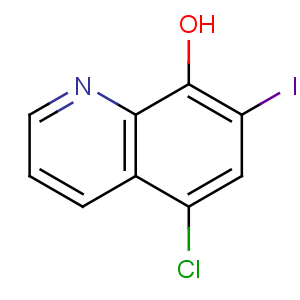Title: Iodochlorhydroxyquin
CAS Registry Number: 130-26-7
CAS Name: 5-Chloro-7-iodo-8-quinolinol
Synonyms: 5-chloro-8-hydroxy-7-iodoquinoline; chloroiodoquin; iodochlorohydroxyquinoline; iodochloroxyquinoline; clioquinol
Trademarks: Amebil; Alchloquin; Amoenol; Bactol; Barquinol; Budoform (Dolder); Chinoform; Cliquinol; Eczecidin; Enteroquinol; Entero-Septol; Enterozol; Entrokin; Hi-Enterol; Iodoenterol; Nioform; Quinambicide; Rometin; Vioform (Novartis)
Molecular Formula: C9H5ClINO
Molecular Weight: 305.50
Percent Composition: C 35.38%, H 1.65%, Cl 11.60%, I 41.54%, N 4.58%, O 5.24%
Literature References: Prepn:
DE 117767 (1899 to Ciba);
US 641491 (1900); A. Das, S. L. Mukherji,
J. Org. Chem. 22, 1111 (1957). Toxicity study: Davis
et al., Am. J. Trop. Med. 24, 29 (1944). Comprehensive description: G. Padmanabhan
et al., Anal. Profiles Drug Subs. 18, 57-90 (1989).
Properties: Brownish-yellow, bulky powder. Practically odorless. Dec ~178-179°. uv max (water/conc. HCl): 266 nm (A1%1cm 990); (0.1
N methanolic NaOH): 269 nm (A1%1cm 1120); (ethanol): 255 nm (A1%1cm 1570). One part dissolves in 43 parts of boiling alc, 128 parts chloroform, 17 parts of boiling ethyl acetate, 170 parts of cold acetic acid, 13 parts of boiling acetic acid. Almost insol in water, cold alc, ether. Soly at room temp (mg/ml): water <0.01, methanol 1.9, ethanol 1.3, ether 5.4, chloroform 14.9, 0.1
N NaOH 17.3, 0.1
N HCl 0.02, acetonitrile between 1.7-2.5, tetrahydrofuran between 20-100, ethyl acetate between 6.7-10, carbon disulfide between 10-20, dimethyl sulfoxide between 20-100, dimethyl acetamide between 20-100. Darkens upon exposure to light. LD50 orally in cats: 400 mg/kg (Davis).
Absorption maximum: uv max (water/conc. HCl): 266 nm (A1%1cm 990); (0.1
N methanolic NaOH): 269 nm (A1%1cm 1120); (ethanol): 255 nm (A1%1cm 1570)
Toxicity data: LD50 orally in cats: 400 mg/kg (Davis)
CAUTION: Has been linked with the occurrence of subacute myelo-optic neuropathy (S.M.O.N. syndrome) in Japan, T. Tsubaki
et al., Lancet 1, 696 (1971);
see also ibid. 1, 534 (1977); J. Tateishi in
Drug-Induced Sufferings T. Soda, Ed. (Excerpta Medica, New York, 1980) pp 464-472.
Therap-Cat: Anti-infective (topical); antiamebic.
Therap-Cat-Vet: Has been used as an intestinal anti-infective.
Keywords: Antiamebic; Antiseptic/Disinfectant; Quinolines.

